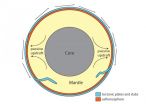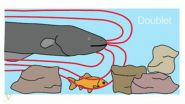A novel role for Ranbp9 in regulating alternative splicing in spermatogenic cells
2014-12-04
(Press-News.org) Highly expressed in the testis, a gene named Ranbp9 has been found to play a critical role in male fertility by controlling the correct expression of thousands of genes required for successful sperm production. A group of researchers led by Professor Wei Yan, at the University of Nevada School of Medicine has discovered that a loss of function of Ranbp9 leads to severely reduced male fertility due to disruptions in sperm development. A paper reporting this finding was published in PLOS Genetics on December 4, 2014.
Male infertility affects 1 out of 20 men of reproductive age worldwide and the underlying causes remain largely unknown. The production of functional sperm is a prerequisite for male fertility, and is achieved through a complex process termed spermatogenesis, which is controlled by numerous genes that are synthesized and processed into messenger ribonucleic acid (mRNA) molecules of different sizes. Disruptions of mRNA processing would lead to aberrant mRNA contents in the developing male germ cells, failed sperm production, and male infertility.
The published study demonstrates that Ranbp9 acts to control the correct processing of mRNA molecules after their syntheses from thousands of genes involved in sperm production. This finding places Ranbp9 as a master regulator of sperm production. Thus, interference of this gene may provide novel diagnostics and therapeutics for male infertility patients, as well as the development of male non-hormonal contraceptives.
INFORMATION:
All works published in PLOS Genetics are open access, which means that everything is immediately and freely available.
Use this URL in your coverage to provide readers access to the paper upon publication: http://www.plosgenetics.org/doi/pgen.1004825
Press-only preview: http://www.plos.org/wp-content/uploads/2014/12/pgen.1004825-Press-Yan.pdf
Contact: Prof. Wei Yan wyan@medicine.nevada.edu
Citation: Bao J, Tang C, Li J, Zhang Y, Bhetwal BP, et al. (2014) RAN-Binding Protein 9 Is Involved in Alternative Splicing and Is Critical for Male Germ Cell
Development and Male Fertility. PLoS Genet 10(12): e1004825. doi:10.1371/journal.pgen.1004825
Funding: This work was supported by grants from the NIH (HD060858, HD071736 and HD074573 to WY). All transgenic mouse lines were generated and/or
maintained in the University of Nevada Genetic Engineering Center (UNGEC) supported by a NIH COBRE grant (P20-RR18751). The Flow Cytometry and Proteomic analyses described here were supported by a grant from the National Institute of General Medical Sciences (8P20GM10344011). The funders had no role in study design, data collection and analysis, decision to publish, or preparation of the manuscript.
Competing Interests: The authors have declared that no competing interests exist.
ELSE PRESS RELEASES FROM THIS DATE:
2014-12-04
A genetic variant which causes smokers to smoke more heavily has been shown to be associated with increased body mass index (BMI) - but only in those who have never smoked, according to new research led by the University of Bristol, UK and published today in PLOS Genetics.
It is likely that this finding has not come to light before because it has been masked by the effect of smoking, which acts to reduce BMI.
Professor Marcus Munafo from Bristol's School of Experimental Psychology and colleagues studied a variant in the CHRNA5-A3-B4 gene cluster which is known to increase ...
2014-12-04
Researchers from the Medical Research Council Lifecourse Epidemiology Unit (MRC LEU), University of Southampton have shed new light on how grip strength changes across the lifespan. Previous work has shown that people with weaker grip strength in midlife and early old age are more likely to develop problems, such as loss of independence and to have shorter life expectancy. However, there is little information on what might be considered a normal grip strength at different ages.
This latest research, which combined information from 12 British studies and is published in ...
2014-12-04
An international team, including scientists from DESY, has caught a light sensitive biomolecule at work with an X-ray laser. The study proves that X-ray lasers can capture the fast dynamics of biomolecules in ultra slow-motion, as the scientists led by Prof. Marius Schmidt from the University of Wisconsin-Milwaukee write in the journal Science. "Our study paves the way for movies from the nano world with atomic spatial resolution and ultrafast temporal resolution", says Schmidt.
The researchers used the photoactive yellow protein (PYP) as a model system. PYP is a receptor ...
2014-12-04
The temperature of the seawater around Antarctica is rising according to new research from the University of East Anglia.
New research published today in the journal Science shows how shallow shelf seas of West Antarctica have warmed over the last 50 years.
The international research team say that this has accelerated the melting and sliding of glaciers in the area, and that there is no indication that this trend will reverse.
It also reveals that other Antarctic areas, which have not yet started to melt, could experience melting for the first time with consequences ...
2014-12-04
CORVALLIS, Ore. - Scientists may have solved a long-standing enigma known as the African Humid Period - an intense increase in cumulative rainfall in parts of Africa that began after a long dry spell following the end of the last ice age and lasting nearly 10,000 years.
In a new study published this week in Science, an international research team linked the increase in rainfall in two regions of Africa thousands of years ago to an increase in greenhouse gas concentrations. The study was funded by the National Science Foundation and the U.S. Department of Energy.
The ...
2014-12-04
A long-held assumption about the Earth is discussed in today's edition of Science, as Don L. Anderson, an emeritus professor with the Seismological Laboratory of the California Institute of Technology, and Scott King, a professor of geophysics in the College of Science at Virginia Tech, look at how a layer beneath the Earth's crust may be responsible for volcanic eruptions.
The discovery challenges conventional thought that volcanoes are caused when plates that make up the planet's crust shift and release heat.
Instead of coming from deep within the interior of the ...
2014-12-04
VIDEO:
Vanderbilt biologist Kenneth Catania describes his discovery that the electroshock system used by the electric eel to detect and immobilize prey is uncannily similar to the Taser.
Click here for more information.
The electric eel - the scaleless Amazonian fish that can deliver an electrical jolt strong enough to knock down a full-grown horse - possesses an electroshock system uncannily similar to a Taser.
That is the conclusion of a nine-month study of the way in which ...
2014-12-04
The "survival of the fittest" principle applies to cells in a tissue - rapidly growing and dividing cells are the fit ones. A relatively less fit cell, even if healthy and viable, will be eliminated by its more fit neighbors. Importantly, this selection mechanism is only activated when cells with varying levels of fitness are present in the same tissue. If a tissue only consists of less fit cells, then no so-called cell competition occurs. Molecular biologists from the University of Zurich and Columbia University are the first researchers to demonstrate in a study published ...
2014-12-04
Since 2010, detections of Asian Carp environmental DNA or "eDNA" have warned scientists, policymakers, and the public that these high-flying invaders are knocking on the Great Lakes' door. Scientists capture tiny DNA-containing bits from water and use genetic analysis to determine if any Asian Carp DNA is present. New research published by Notre Dame scientists shows that the tools currently used for Asian Carp eDNA monitoring often fail to detect the fish. By comparison, the new eDNA methods described in this study capture and detect Asian Carp eDNA more effectively.
The ...
2014-12-04
ITHACA, N.Y. - Among the billions and billions of stars in the sky, where should astronomers look for infant Earths where life might develop? New research from Cornell University's Institute for Pale Blue Dots shows where - and when - infant Earths are most likely to be found. The paper by research associate Ramses M. Ramirez and director Lisa Kaltenegger, "The Habitable Zones of Pre-Main-Sequence Stars" will be published in the Jan. 1, 2015, issue of Astrophysical Journal Letters.
Images and study: https://cornell.box.com/infantearths
"The search for new, habitable ...
LAST 30 PRESS RELEASES:
[Press-News.org] A novel role for Ranbp9 in regulating alternative splicing in spermatogenic cells

